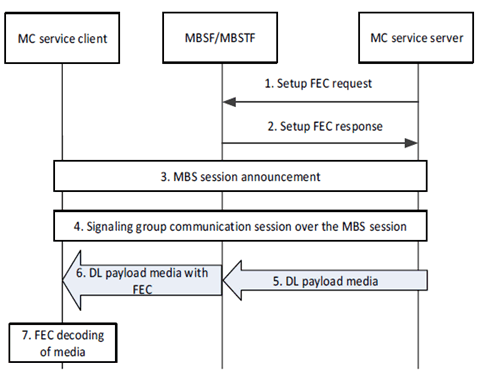Content for TS 23.289 Word version: 19.0.0
0…
4…
4.7…
4.7.4…
4.8…
5…
5.4…
6…
6.3…
6.3.2…
7…
7.2.4…
7.3…
7.3.3…
7.3.3.2…
7.3.3.4…
7.3.3.5…
7.3.3.7…
7.3.3.8…
7.3.3.9…
7.3.3.10…
7.3.3.11…
7.3.3.12…
7.3.3.13…
7.4…
7.5…
7.6…
A…
7.3.3.13 Use of FEC to protect 5G MBS transmissions
7.3.3.13.1 General
7.3.3.13.2 FEC encoding by the MBSTF
...
...
7.3.3.13 Use of FEC to protect 5G MBS transmissions p. 99
7.3.3.13.1 General p. 99
Application layer FEC can be used to recover the packet losses when delivering a MC service over 5G MBS, to reach its required level of QoS.
The support of FEC is optional for the MC service servers and MC service clients. FEC can be optionally applied by the MBSTF, if required by the MC service server (as specified in clause 7.3.3.13.2), or directly by the MC service server (as defined in TS 23.280).
7.3.3.13.2 FEC encoding by the MBSTF p. 99
In this procedure, depicted in Figure 7.3.3.13.2-1, the MC service server asks the MBSF/MBSTF to apply FEC to a set of media, transported by a 5G MBS session, using the Setup FEC request.
This procedure can be applied when using pre-created MBS session and session announcement (as specified in clause 7.3.3.1.2) or using MBS session and session announcement (as specified in clause 7.3.3.1.3).
Pre-condition:
- The MC service server has already configured and activated a 5G MBS session.

Step 1.
The MC service server decides to set up FEC for a set of MC service media flows. It will send the FEC request to MBSF/MBSTF.
It includes the following elements: the MBS session ID of the MBS session transporting those media, the media descriptions (codecs, transport protocols, bitrates, destination IP addresses and ports), the identification of the FEC repair packet flow (IP destination and port), and an upper bound to the additional latency resulting due to FEC application. The MC Service server may perform this request several times to protect separately different sets of media transported within the same 5G MBS session.
Step 2.
If the MBSF can satisfy the request, the Setup FEC response includes a modified list of media information and FEC information. The response also includes an identifier of the corresponding FEC process instance, which can be used to release the application of FEC for these media flows.
Step 3.
The MC service server announces the 5G MBS session to the MC service client with the MBS session announcement procedure, including the modified list of media information and FEC information within the SDP information.
Step 4.
When the MC service server decides to transmit the MC service media flow for a group communication, the MC service server sends to the group a message identifying the MC service media flow and the MBS session ID, such as the MapGroupToSessionStream message for MCPTT or MCVideo.
Step 5.
The MC service server sends the downlink media to the MBSTF over Nmb8.
Step 6.
The MBSTF performs FEC encoding of the downlink media in accordance with the announced FEC algorithm and parameters and delivers it over 5G MBS.
Step 7.
The MC service client performs FEC decoding of the encoded media flows in accordance with the announced FEC information and delivers the decoded flows to the media player.